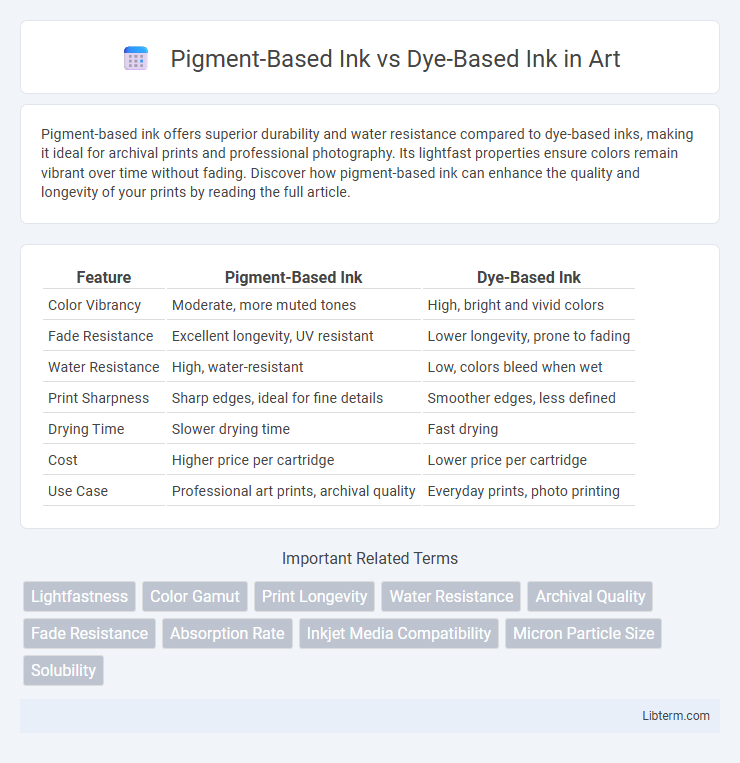Pigment-based ink offers superior durability and water resistance compared to dye-based inks, making it ideal for archival prints and professional photography. Its lightfast properties ensure colors remain vibrant over time without fading. Discover how pigment-based ink can enhance the quality and longevity of your prints by reading the full article.
Table of Comparison
| Feature | Pigment-Based Ink | Dye-Based Ink |
|---|---|---|
| Color Vibrancy | Moderate, more muted tones | High, bright and vivid colors |
| Fade Resistance | Excellent longevity, UV resistant | Lower longevity, prone to fading |
| Water Resistance | High, water-resistant | Low, colors bleed when wet |
| Print Sharpness | Sharp edges, ideal for fine details | Smoother edges, less defined |
| Drying Time | Slower drying time | Fast drying |
| Cost | Higher price per cartridge | Lower price per cartridge |
| Use Case | Professional art prints, archival quality | Everyday prints, photo printing |
Introduction to Ink Types: Pigment vs Dye
Pigment-based ink contains solid color particles suspended in a liquid carrier, offering superior water resistance and longevity compared to dye-based ink, which dissolves colorants directly into the liquid for vibrant, sharp prints. Pigment ink excels in archival quality and outdoor durability, making it ideal for professional photo printing and documents requiring fade resistance. Dye-based ink provides a wider color gamut and faster drying times, suitable for everyday printing tasks where vivid colors and smooth gradients are prioritized.
Chemical Composition of Pigment and Dye Inks
Pigment-based ink contains solid color particles suspended in a liquid carrier, which resist water and UV exposure due to their larger molecular structure, ensuring longer-lasting prints. Dye-based ink consists of water-soluble color molecules that penetrate paper fibers, offering vibrant colors but with lower resistance to fading and smudging. The chemical composition of pigment inks involves insoluble pigments, while dye inks rely on soluble organic dyes, influencing their durability and color intensity.
Color Vibrancy and Quality Comparison
Pigment-based ink offers superior color vibrancy and durability due to its larger, solid particles that resist fading and water damage, making it ideal for archival-quality prints. Dye-based ink delivers more vivid and bright colors with smoother gradients, but it tends to be less resistant to light and moisture, resulting in faster color degradation. For applications requiring long-lasting, high-quality color, pigment-based ink provides enhanced stability and richness, whereas dye-based ink excels in sharpness and vibrancy for short-term use.
Print Longevity and Fade Resistance
Pigment-based inks offer superior print longevity and fade resistance due to their larger, stable particles that sit on the surface of the paper, making them less prone to water and UV damage. Dye-based inks, while vibrant and bright, tend to penetrate paper fibers and are more susceptible to fading over time, especially when exposed to sunlight and humidity. For archival quality prints, pigment-based inks are preferred for their enhanced durability and resistance to environmental factors.
Water and Smudge Resistance Differences
Pigment-based ink consists of solid color particles suspended in a liquid, offering superior water and smudge resistance compared to dye-based ink, which dissolves colorants and tends to bleed when exposed to moisture. The larger particle size of pigment ink enables it to bond effectively to paper surfaces, resulting in sharper prints and enhanced durability against water damage. Dye-based inks provide vibrant colors but remain more susceptible to smearing and fading when wet, making pigment inks the preferred choice for archival-quality documents and outdoor applications.
Print Media Compatibility
Pigment-based ink offers superior print media compatibility, adhering well to a wide range of surfaces including coated and uncoated papers, textiles, and synthetic materials due to its larger particle size. Dye-based ink excels on glossy and photo papers, delivering vibrant colors but often struggles with longevity on porous or rough media. Choosing between pigment and dye ink depends on the printing substrate, desired durability, and color vibrancy requirements.
Cost and Yield Analysis
Pigment-based ink typically costs more upfront due to its complex particle formulation but offers higher yield as it produces more durable, water-resistant prints, leading to less frequent reprinting. Dye-based ink is generally cheaper but has a lower yield because it tends to fade faster and requires frequent replacements, increasing long-term expenses. Evaluating total cost of ownership, pigment-based inks provide better value for high-volume or archival printing applications due to their longevity and efficient ink usage.
Applications: Best Uses for Each Ink Type
Pigment-based ink is ideal for archival-quality prints, professional photography, and outdoor signage due to its superior water resistance and UV durability, ensuring long-lasting color retention. Dye-based ink excels in producing vibrant, high-resolution images on glossy photo paper, making it a preferred choice for everyday photo printing and detailed graphic work. Selecting the appropriate ink depends on the intended application, with pigment inks favored for longevity and dye inks chosen for vivid color reproduction.
Environmental Impact and Safety
Pigment-based inks contain larger particles that are less likely to penetrate skin or water systems, making them generally safer and more environmentally friendly due to reduced chemical leaching. Dye-based inks, while offering vibrant colors, often use synthetic solvents and dyes that can be toxic and less biodegradable, increasing environmental pollution risks. Choosing pigment-based ink supports sustainability by minimizing harmful emissions and promoting safer disposal.
Choosing the Right Ink for Your Needs
Pigment-based ink offers superior water and fade resistance, making it ideal for archival documents and professional-quality prints requiring longevity. Dye-based ink delivers vibrant colors and smoother gradients, preferred for photo printing and everyday use where rich color output is essential. Selecting the right ink depends on your priorities for durability, color vibrancy, and the type of paper or material used.
Pigment-Based Ink Infographic

 libterm.com
libterm.com